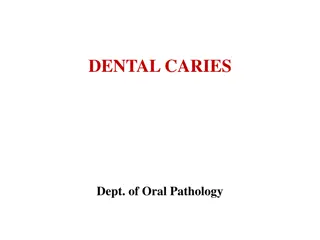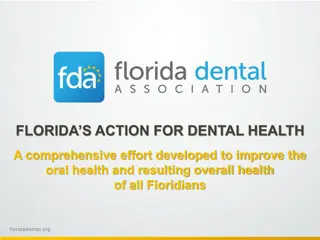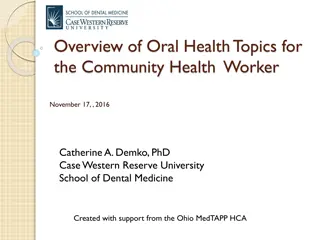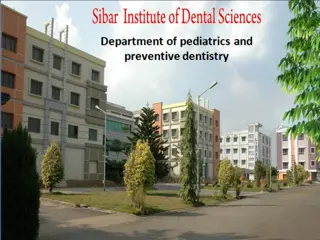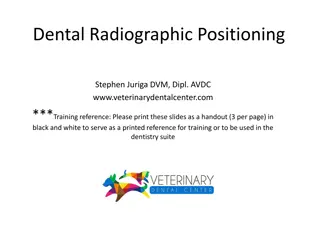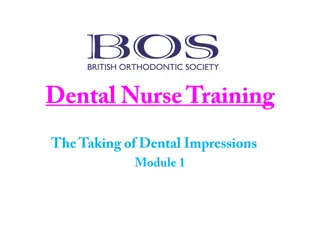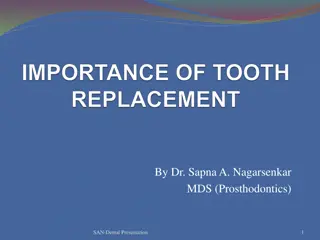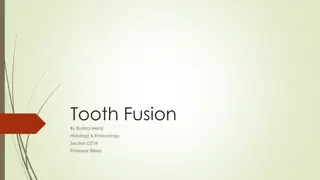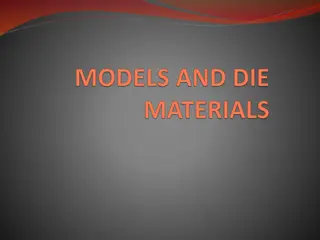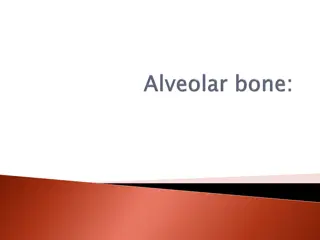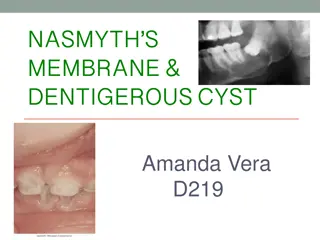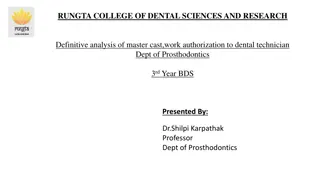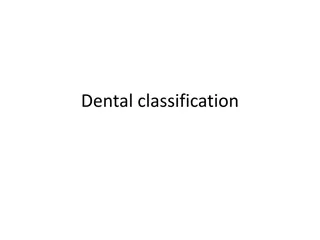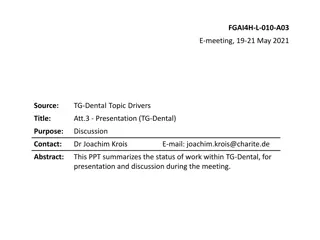Understanding Dental Caries: Causes and Prevention
Dental caries, also known as tooth decay, is a common microbial disease affecting teeth, characterized by demineralization and destruction of tooth tissue. This comprehensive guide explores the causes, progression, and prevention strategies of dental caries, including demineralization and remineralization processes. Learn about primary and secondary caries, active and arrested lesions, and the importance of oral hygiene in combating this prevalent dental issue.
Download Presentation

Please find below an Image/Link to download the presentation.
The content on the website is provided AS IS for your information and personal use only. It may not be sold, licensed, or shared on other websites without obtaining consent from the author. Download presentation by click this link. If you encounter any issues during the download, it is possible that the publisher has removed the file from their server.
E N D
Presentation Transcript
Dental Caries- Histoplathology Dr. Rhythm Assistant Professor
Dental caries or tooth decay is one of the most common of all disorders, second only to common cold. Dental caries has afflicted more humans longer than any other disease. It was first appeared about 14000 years ago. From that time to the present, dental caries affected almost all human populations, at all socioeconomic levels, and at all ages.
What is Dental Caries? It is a microbial disease of the calcified tissues of the teeth, characterized by demineralization of the inorganic portion and destruction of the organic substance of the tooth.
It is dietary carbohydrate modified, infectious, microbial disease affecting the teeth
Demineralization: When sugar and other fermentable carbohydrates reaches the bacteria, they form acids which start to dissolve the enamel - an early caries lesion occurs due to loss of Calcium and Phosphates Remineralization: When sugar consumption has ceased, saliva can wash away sugars and buffer the acids. Calcium and Phosphates can again enter the tooth. The process is strongly facilitated by fluorides
1. A tooth surface without caries. 2.The first signs of demineralization. 3.The enamel surface has broken down. 4.A filling has been made but the demineralization has not been stopped. 5.The demineralization proceeds and undermines the tooth. 6.The tooth has fractured.
Primary Caries: lesions on unrestored tooth surface. Secondary (recurrent) caries: lesions that developed adjacent to a filling. Residual caries: demineralized tissue that has been left behind before a filling is placed.
Active caries lesion: a progressive carious lesion. Arrested (inactive) carious lesion: A lesion that may have formed years previously and then stopped further progression.
White spot caries: the first sign of a caries lesion on enamel that can be detected with the naked eye. Also known as initial or incipient caries. Rampant caries: is the name given to multiple active carious lesions occurring in the same patient. This frequently involves surfaces of teeth that do not usually experience dental caries e.g, bottle or nursing caries, baby caries, radiation caries, or drug-induced caries.
CARIES OF ENAMEL Smooth surface Caries: Due to plaque formation on enamel. The earliest manifestation of incipient caries (early caries) of enamel is usually seen beneath dental plaque as areas of decalcification (white spots).
The first change seen histologically is the loss of inter-rod substance of enamel with increased prominence of the rods. -this is followed by the loss of mucopolysaccharides in the organic substance. -presence of transverse striations of the enamel rods, - accentuated incremental lines of Retzius
As it goes deeper, the caries forms a triangular pattern or cone shaped lesion with the apex towards DEJ and base towards the tooth surface. Finally there is loss of enamel structure, which gets roughened due to demineralization, and disintegration of enamel prisms.
Zone 1: Translucent zone, -lies at the advancing front of the lesion, -slightly more porous than sound enamel, -it is not always present Zone 2: Dark zone, - this zone is usually present and referred to as positive zone -formed due to demineralization.
Zone 3: Body of the lesion, -found between the surface and the dark zone, -it is the area of greatest demineralization, Zone 4: Surface zone, -relatively unaffected area, -greater resistance probably due to greater degree of mineralization and greater F concentration.
CARIES OF DENTIN Begins with the natural spread of the process along the DEJ and rapid involvement of the dentinal tubules. The dentinal tubules act as tracts leading to the pulp (path for micro- organisms).
Early Dentinal Changes: -initial penetration of the dentin by caries dentinal sclerosis, -calcification of dentinal tubules and sealing off from further penetration by micro-organisms, -more prominent in slow chronic caries.
In the earliest stages, when only few tubules are involved, microorganisms may be found penetrating the tubules Pioneer Bacteria.
MCQs Q.1 Dental caries is A. infectious microbial disease B. infectious non-microbial disease C. non-infectious microbial disease D. non-infectious, non-microbial disease.
Q.2 First histological change in dental caries is: A. loss of mucopolysacchraides B. loss of enamel rods C. loss of collagen fibres D. loss of enamel
Q.3 Chalky appearance of tooth represents A. incipient lesion B. cavitated lesion C. dentinal caries D. root caries
Q.4 Zone present next to advancing front of caries is A. Transluscent zone B. Dark zone C. Deep zone D. Dead zone
Q.5 Carious enamel when compared to sound enamel is A. more porous B. less porous C. equally porous D. not porous
Q.6 Which zone is called the psoitive zone A. Dead zone B. Dark zone C. Deep zone D. Deminerialized zone
Q.7 Which zone is called the body of the lesion A. Zone1 B. Zone 2 C. Zone 3 D. Zone 4
Q.8 Which zone has highest fluoride concentration A. Surface zone B. Zone 3 C. Advancing front D. Zone 2
Q.9 Caries progression shows a A. cyclic pattern B. static pattern C. stationary pattern D. stagnant pattern
Q. 10 Incipent lesions can be A. Remineralised and are reversilble B. Reminalised but non-reversible C. cannot be remineralised but reversible D. cannot be remineralised,, non reversible.



